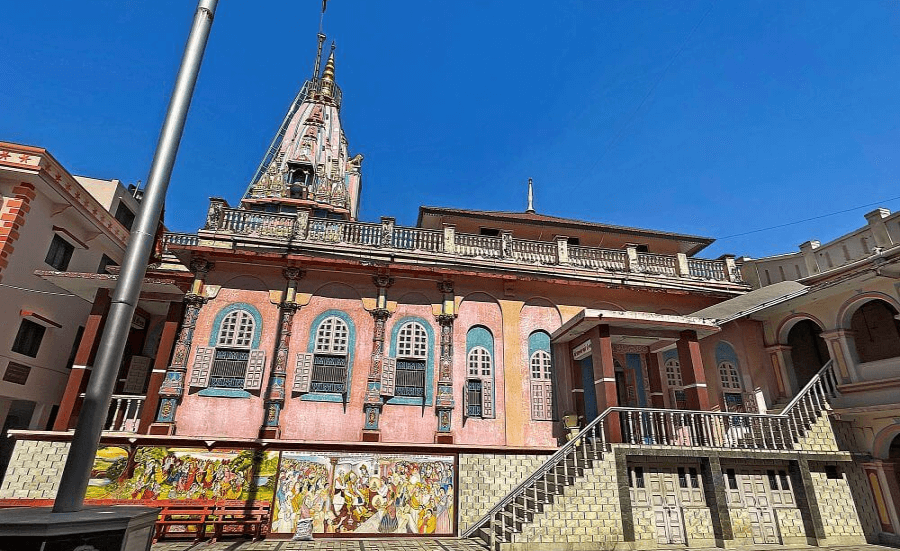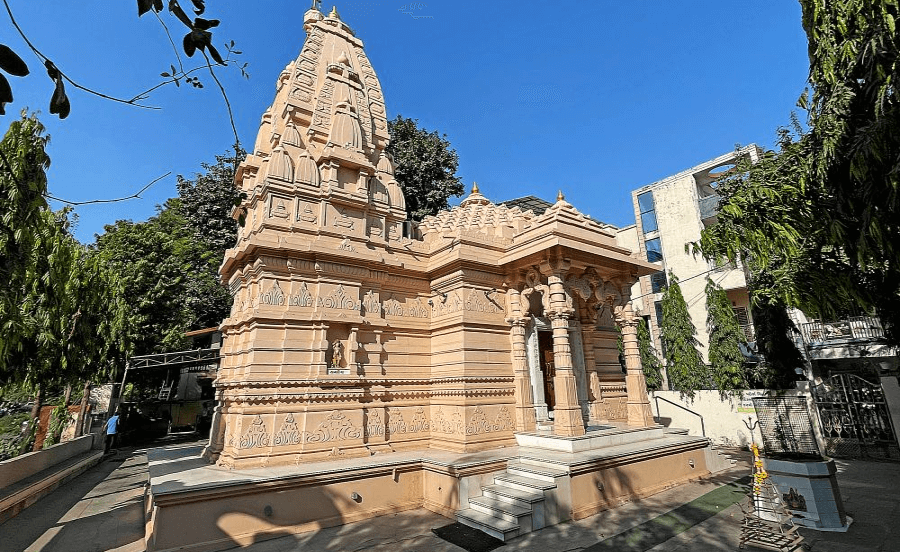
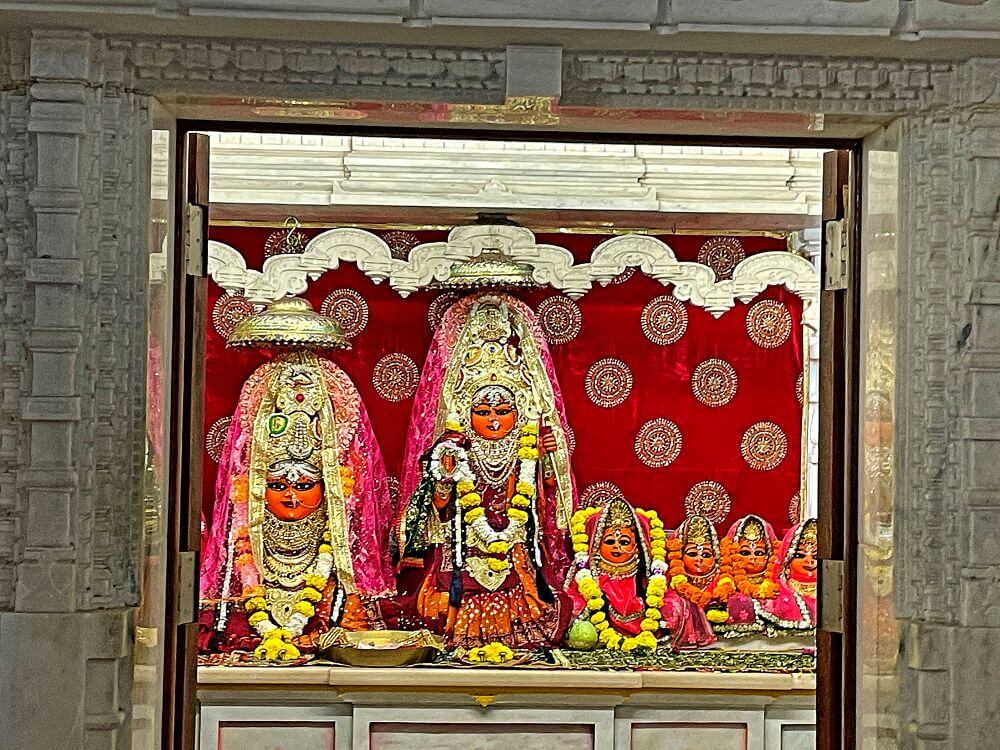 Khodiyar Mata, revered as a warrior goddess in Gujarat and Rajasthan, holds a special place in the hearts of devotees. Numerous legends surround her birth, with one linking her origin to the period of Maitraka dynasty under King Shiladitya III of Saurashtra. Temples dedicated to Khodiyar Mata can be found across the region, including this well-known Khodiyar Mataji Temple in Adajan, Surat. Constructed in striking red stone, this temple is a centre of devotion for thousands of devotees in the surrounding areas. The temple attracts large crowds, particularly during Navratri and Khodiyar Mata’s birth anniversary celebrations.
Khodiyar Mata, revered as a warrior goddess in Gujarat and Rajasthan, holds a special place in the hearts of devotees. Numerous legends surround her birth, with one linking her origin to the period of Maitraka dynasty under King Shiladitya III of Saurashtra. Temples dedicated to Khodiyar Mata can be found across the region, including this well-known Khodiyar Mataji Temple in Adajan, Surat. Constructed in striking red stone, this temple is a centre of devotion for thousands of devotees in the surrounding areas. The temple attracts large crowds, particularly during Navratri and Khodiyar Mata’s birth anniversary celebrations.
Khodiyar Mata is the kuldevi (family deity) of communities such as Paradhi, Jograna, Charan, Rajput, Baniya, Brahmin, Ahir, Bharwad, Patel, Bhoi Gurjar, Devi-Pujak (Vaghri), and Lohar-Suthar.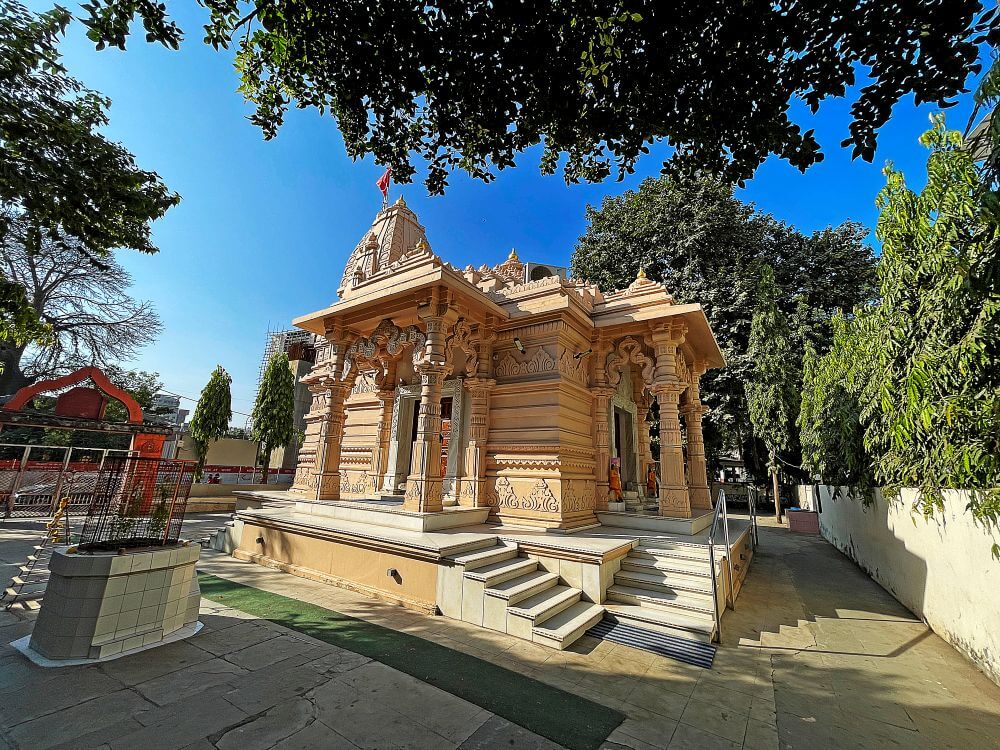 One legend describes Khodiyar Mata as the daughter of Rishi Dadhichi and his wife Sushila. According to the legends, Dadhichi was a master of a Vedic rite known as the Madhu Vidya, through which one can obtain relative immortality in Brahma Loka, the highest heaven.
One legend describes Khodiyar Mata as the daughter of Rishi Dadhichi and his wife Sushila. According to the legends, Dadhichi was a master of a Vedic rite known as the Madhu Vidya, through which one can obtain relative immortality in Brahma Loka, the highest heaven.
Another narrative recounts Khodiyar Mata’s birth in 700 CE in the home of Mamadiya Gadhvi, a cattleman of the Leuva Patel community in Roishra village, Bhavnagar district. Bhavnagar, a region in Saurashtra, was ruled during ancient times by King Shiladitya III Sen. During his reign, Maharaja Shilbhadra was the ruler of Bhavnagar and shared a close friendship with Mamadiya Gadhvi, a respected figure in the community. This strong bond between the king and Mamadiya sparked jealousy among the royal ministers, who began poisoning the minds of the king and queen against Mamadiya. While the king remained unaffected by their slander, the queen started believing the ministers’ words.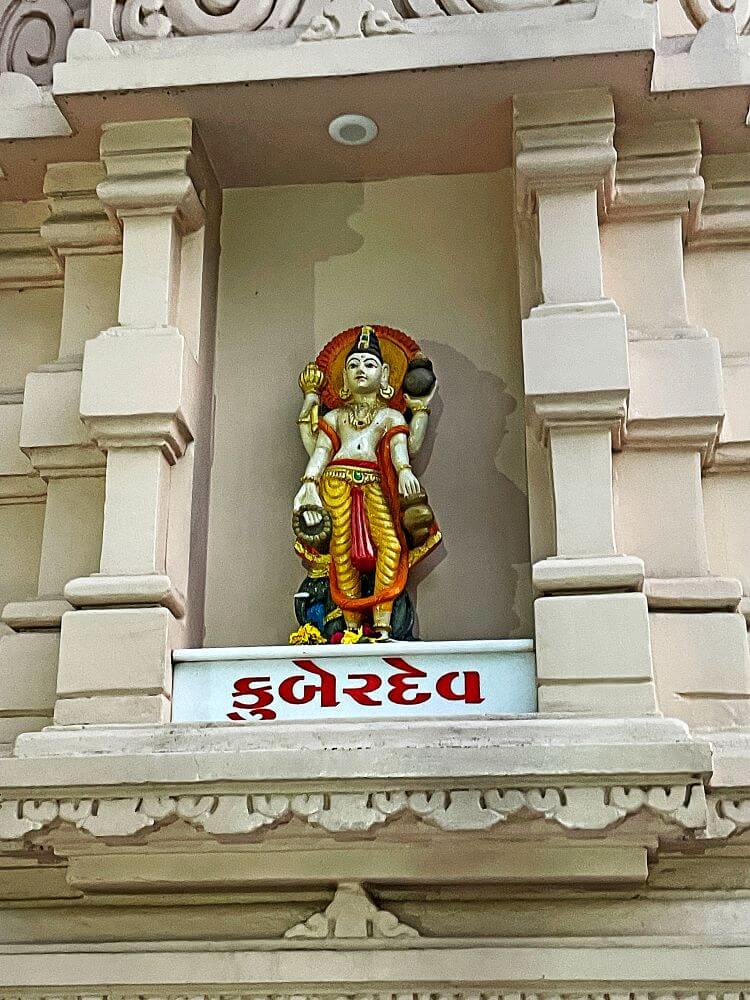
One day, when Mamadiya Gadhvi visited the royal palace, the gatekeeper stopped him, citing a rule that childless individuals were forbidden from entering the palace. Insulted and deeply distressed, Mamadiya returned home and resolved to perform intense prayers to Lord Shiva for the blessing of children. He undertook a lotus ritual (kamal puja)and fervently pleaded with Lord Shiva, vowing to sacrifice himself if his prayers went unanswered. As he began inflicting harm upon himself, Lord Shiva appeared before him. Moved by Mamadiya’s devotion, Shiva took him to the Netherworld (Patal Lok) to meet the serpent king, Nagaraja. With Shiva’s blessing and command, Nagaraja granted Mamadiya a boon that he would be blessed with seven daughters and one son. Over time, Mamadiya and his family were blessed with seven daughters—Avadh, Jogad, Togad, Bijbai, Holbai, Sosai, and Janbai—and a son named Merakhia.
One day, while Merakhia, the son of Mamadiya Gadhvi, was playing outside, he was bitten by a venomous snake. The poison quickly spread through his body, causing his skin to turn black and blue and foam to appear at his mouth. Despite the villagers’ best efforts to neutralize the poison, all remedies failed. At this time, an elderly person suggested, “If someone can bring the Amrit Kalash (pot of nectar) from Nagaraja in the Netherworld (Patal Lok) before sunrise,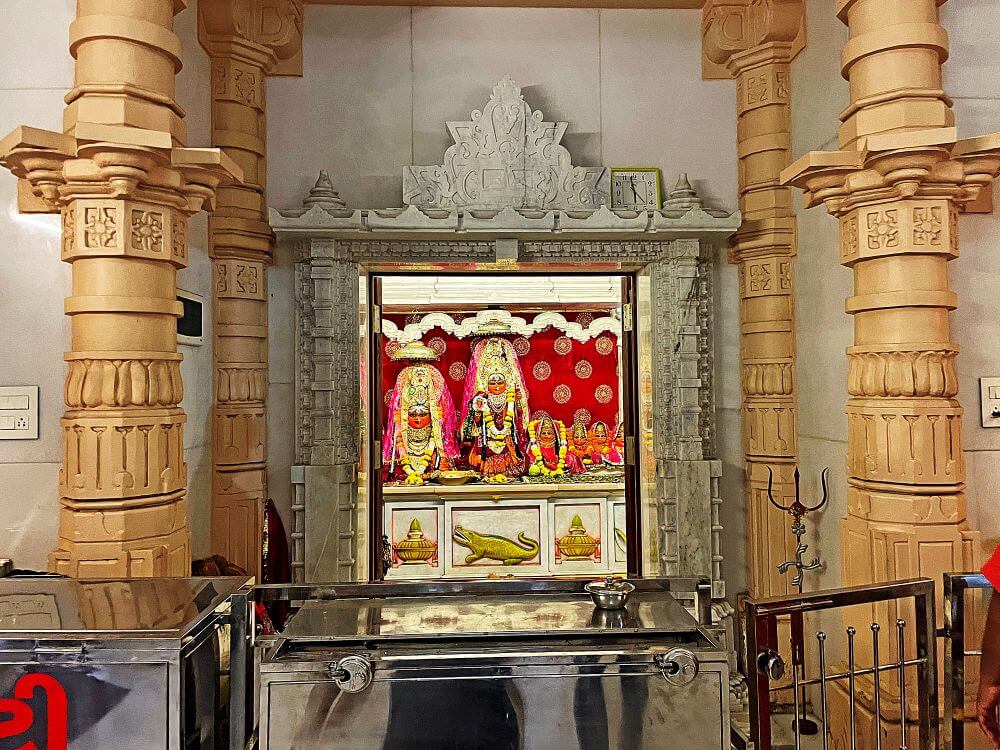 Merakhia’s life can be saved.” Hearing this, Janbai, Mamadiya Gadhvi’s youngest daughter, volunteered to undertake the dangerous journey to the Netherworld to retrieve the Amrit Kalash.
Merakhia’s life can be saved.” Hearing this, Janbai, Mamadiya Gadhvi’s youngest daughter, volunteered to undertake the dangerous journey to the Netherworld to retrieve the Amrit Kalash.
Janbai bravely ventured into the Patal Lok and obtained the Amrit Kalash from Nagaraja. However, during her return journey, she injured her leg, making it difficult for her to walk. The delay in her return caused immense anxiety for Mamadiya Gadhvi and the villagers. Unable to walk further, Janbai climbed onto the back of a crocodile and reached home safely. She gave Merakhia the nectar from the Amrit Kalash, and as soon as he consumed it, he was healed completely. However, due to her injury, Janbai developed a limp, earning her the name Khodiyar Mata (from “khoda,” meaning limp). 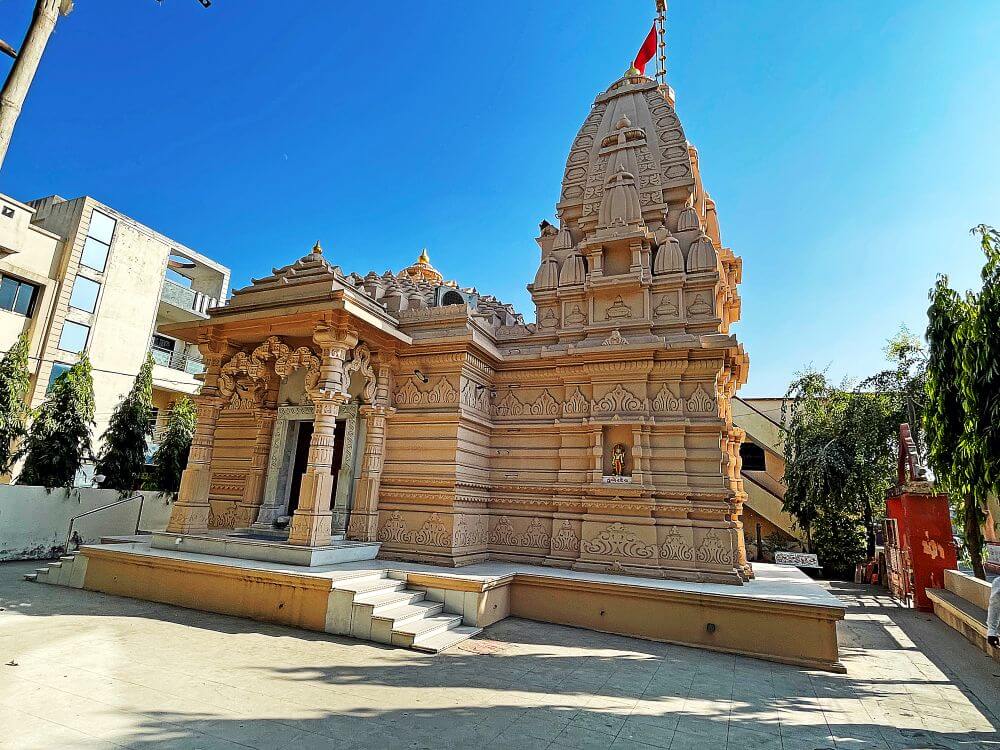 Her journey on the back of a crocodile established the crocodile as her sacred vehicle (vahana).Today, many devotees revere Khodiyar Mata as an incarnation of Goddess Durga and worship her with great devotion.
Her journey on the back of a crocodile established the crocodile as her sacred vehicle (vahana).Today, many devotees revere Khodiyar Mata as an incarnation of Goddess Durga and worship her with great devotion.
Renovated over a century ago, the Khodiyar Mataji Temple is set within a spacious complex enclosed by a boundary wall. The temple’s grand entrance gate features sculptures of guards dressed in traditional attire, with a striking arch displaying an idol of Khodiyar Mata holding a trident (trishul). Nearby are statues of her six sisters and her crocodile mount. The temple’s shikhara (spire) is intricately carved, with niches on the outer walls housing idols of deities like Kubera, Varuna, and Yama. Built in the Gujarati architectural style, the temple comprises a mukhamandapa (entrance hall), sabhamandapa (assembly hall), and garbhagriha (sanctum sanctorum).
Inside the sanctum, the richly adorned idol of Khodiyar Mata stands holding a trident. Flanked by statues of her sisters, the idol is crowned with a golden crown and sheltered by a canopy. Beneath the sanctum’s platform are carvings of her crocodile mount, a deer, and a kalash (sacred pot).
The temple hosts various religious events throughout the year, with grand celebrations for Chaitra Navratri, Sharadiya Navratri, and Mataji’s birth anniversary on Magha Shukla Ashtami. Devotees from surrounding areas gather in large numbers to participate in the festivities.
